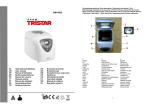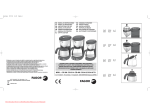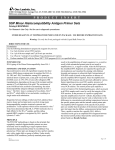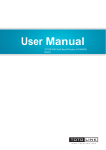Download Terms, procedure and mode for the use of - B
Transcript
TERMS, PROCEDURE AND MODE FOR THE USE OF QUALIFIED ELECTRONIC SIGNATURE AND TIME STAMP TOKEN
B-Trust
TERMS, PROCEDURE AND MODE
FOR THE USE OF
QUALIFIED ELECTRONIC SIGNATURE
AND
TIME STAMP TOKEN
Version 1.0
February, 2012
"BORICA - BANKSERVICE" JSC, February 2012
Page 1 of 12
B-Trust
TERMS, PROCEDURE AND MODE FOR THE USE OF QUALIFIED ELECTRONIC SIGNATURE AND TIME STAMP TOKEN
CONTENTS
LIST OF TERMS AND ABBREVIATIONS ............................................................................................ 3
INTRODUCTION ............................................................................................................................ 4
I.
TERMS, PROCEDURE AND MODE FOR THE USE OF QUALIFIED ELECTRONIC SIGNATURE .......... 5
1.
General rules on the use of the signature.................................................................................. 5
2.
Rules for signing ........................................................................... Error! Bookmark not defined.
3.
Way of use – trusted software applications............................................................................... 6
4.
Constrains on the use of the signature ...................................................................................... 6
5.
Obligations of the Author and the Titular upon signing ............................................................ 7
6.
Technical security and control ................................................................................................... 7
7.
Secrecy of the private key .......................................................................................................... 7
8.
Generation of a new pair of keys ............................................................................................... 7
9.
Compromising of the private key ............................................................................................... 8
10. Destroying of private key ........................................................................................................... 8
11. Activation and deactivation of private key ................................................................................ 8
II.
ACCEPTANCE OF THE SIGNATURE....................................................................................... 8
1.
Confidence in the electronic signature ...................................................................................... 8
2.
Due care of the Trusting party ................................................................................................... 8
III.
TERMS, PROCEDURE AND MODE OF USE OF THE TIME STAMP TOKEN .............................. 11
1.
General rules ............................................................................................................................ 11
2.
Issue of TST ............................................................................................................................... 11
3.
Mode of use of TST................................................................................................................... 11
4.
Constrain of the use of TST ...................................................................................................... 11
5.
Obligations of the parties in the use of TST ............................................................................. 11
6.
Technical security and control ................................................................................................. 12
IV.
ACCEPTANCE OF THE TIME STAMP TOKEN ....................................................................... 12
1.
Confidence in the TST ............................................................................................................... 12
2.
Due care of the Trusting party ................................................................................................. 12
"BORICA - BANKSERVICE" JSC, February 2012
Page 2 of 12
B-Trust
TERMS, PROCEDURE AND MODE FOR THE USE OF QUALIFIED ELECTRONIC SIGNATURE AND TIME STAMP TOKEN
List of terms and abbreviations
In English language:
B-Trust®
CA
CRL
ETSI
FIPS
ISO
OID
OCSP
PKCS
PKI
RA
RSA
SSCD
SHA
SSL
ТSA
TST
Търговска марка на дейността на „Борика-Банксервиз” АД като ДУУ / Trade mark
of the activity of “Borica - Bankservice” JSC as CSP
Certificate Authority – Удостоверяващ орган
Certificates Revocation List – Списък на прекратени удостоверения
European Telecommunications Standard Institute – Европейски институт за
телекомуникационни стандарти
Federal Information Processing Standard – Федерален Стандарт за обработка на
информация
International Standard Organization – Международна Организация по стандарти
Object Identifier – Идентификатор на обект
On-line Certificate Status Protocol – Протокол за проверка на статус на
удостоверение в реално време
Public Key Cryptography Standards – Криптографски Стандарти на публични
ключове
Public Key Infrastructure – Инфраструктура на публични ключове
Registry Authority – Регистриращ орган
Rivers-Shamir-Adelman – Криптографски алгоритъм (асиметричен)
Secure Signature Creation Device –Устройство за създаване на сигурен електронен
подпис
Secure Hash Algorithm – Хеш функция
Secure Socket Layer – Защитена HTTP сесия
Time Stamp Authority – Орган на удостоверения за време
Time Stamp Token – Удостоверение за време
In Bulgarian language:
АД/JSC
ДУУ/CSP
ЗЕДЕП/LEDES
Акционерно дружество /Joint-Stock Company
Доставчик на Удостоверителни Услуги/Certificate Services Provider
Закон за електронния документ и електронния подпис/Law on Electronic
Document and Electronic Signature
ЗЕУ/LEG
Закон за Електронно Управление (е-Управление)/Law on Electronic
Governance (e-Governance)
КРС/CRC
Комисия за регулиране на съобщенията/Communications Regulation
Commission
МРС/LRO
Местна Регистрираща Служба/Local Registry Office
НДДУУ/OACSP
Наредба за дейността на доставчиците на удостоверителни
услуги/Ordinance on the Activities of Certificate Service Providers
НИАКЕП/ORQESA
Наредба за изискванията към алгоритмите за квалифициран електронен
подпис/Ordinance on the Requirements for Qualified Electronic Signature
Algorithms
Наръчник/User Manual
Наръчник на потребителя за предоставяните от "БОРИКА БАНКСЕРВИЗ" АД B-TRUST® удостоверителни, информационни,
криптографски и консултантски услуги за квалифициран
"BORICA - BANKSERVICE" JSC, February 2012
Page 3 of 12
B-Trust
TERMS, PROCEDURE AND MODE FOR THE USE OF QUALIFIED ELECTRONIC SIGNATURE AND TIME STAMP TOKEN
Практика/CPS
Политика/CP
КЕП/QES
електронен подпис/User Manual on the provision of certification,
information, encryption and consulting services for qualified
electronic signature by “BORICA - BANKSERVICE” JSC B-TRUST ®
Практика на предоставяне на удостоверения за квалифициран
електронен подпис, Практика на органа за удостоверяване на време/
Certificate Practice Statement of the QES Certificate Services Provider,
Certificate Practice Statement of the Time Stamp Authority
Политика на предоставяне на удостоверения за
квалифициран
електронен подпис, Политика на органа за удостоверяване на време/
Certificate Policy of the QES Certificate Services Provider, Certificate Policy of
the Time Stamp Authority
Квалифициран Електронен Подпис/Qualified Electronic Signature
Introduction
This document describes:
The mode of use of the qualified electronic signature (QES), for which the relevant
qualified certificate has been issued on the Author/Titleholder, as well as the mode of use
of the time stamps token issued by the CSP “BORICA-BANKSERVICE” JSC;
The terms and procedure for the use of QES, including the requirements for the treasure
up of the Author’s/Titular’s private key, and the terms and procedure for the use of the
time stamps token;
Terms for the access to a certificate for QES and time stamp token, as well as the method
to verify the QES and the time stamp token.
Based on this document each Author/Titular of certificates for QES and/or Trusting party of a
QES and of a TST shall be able to define, to create and to follow a concrete Policy on
signing/verifying of QES, as well as a Policy on the use of TST.
"BORICA - BANKSERVICE" JSC, February 2012
Page 4 of 12
B-Trust
TERMS, PROCEDURE AND MODE FOR THE USE OF QUALIFIED ELECTRONIC SIGNATURE AND TIME STAMP TOKEN
I.
TERMS, PROCEDURE AND MODE FOR THE USE OF QUALIFIED
ELECTRONIC SIGNATURE
1.
General rules on the use of the signature
1.1. Each Author/Titular utilizes QES in abiding by the following basic requirements:
In adhering strictly to LEDES, to the ordnances on the law implementation and on
the commonly established in the CPS recommendations and standards;
In observing the highest level of treasure up/protection of the private key for
electronic signature by the Author/Titular;
In adhering to the terms and procedures for generating the pair of keys in
accordance with the User Manual, regardless of whether the above-mentioned pair
of keys shall be generated by the CSP or by the Author/Titular;
In observing the terms for access to the private key – use of password/personal
identification number (PIN);
In strict compliance with the measures and procedures for identification and
authentication of the applicant party for a qualified certificate for QES, according to
the User Manual;
In the impossibility for a subsequent use of QES after a smart-card loss, after
destruction of the private key for signing, after expired validity or termination of an
adequate certificate;
In publicly announced CPS, procedures and CP for the provision of certificate
services by the CSP;
In 24/7 public access to the Public Register for the issued CRL for QES and to the
service certificates of the CSP through its Internet site;
In observance of the guarantees and the insurance policy of the CSP;
In respecting of the moral and property rights, in particular the intellectual property
rights of the CSP and the Author/Titular.
2.
Rules for signing
2.1. Before using the private key for signing an electronic document the Author/Titular
must be sure that the corresponding certificate is for QES, i.e. the certificate is
qualified and it is issued in accordance with the CP for this certificate, and the CP
meets the Author/Titular needs;
2.2. It is recommended to check the CP by comparing with the identifiers, specified in the
original copy of the User Manual of the CSP;
"BORICA - BANKSERVICE" JSC, February 2012
Page 5 of 12
B-Trust
TERMS, PROCEDURE AND MODE FOR THE USE OF QUALIFIED ELECTRONIC SIGNATURE AND TIME STAMP TOKEN
2.3. The CP on issuance and maintenance of the certificate for QES is identified in the same
certificate with the following characteristics:
Unique CP OID;
Unique identifier for qualified certificate;
Name of the CSP;
Date of issue and date of entry into force of the CP, which is a consequence of the
date of issue and the date of entry into force of the User Manual;
Applicability to the specific type of certificate.
3.
Way of use – trusted software applications
3.1. Signing with QES must always be performed with trusted software applications or with
software applications certified by the LEG.
3.2. On the CSP’s website there is a published list with the trusted software applications
suitable for the use of QES and for the relevant certificate, in accordance with its
purpose;
3.3. It is in the due care of the Trusting party to check the purpose and the applicability of
the certificate for QES and the software applications used for the creation and
verification of the signature.
3.4. The signing party, respectively the Trusting/verification party principally implements
two ways for signing with QES and for verifying the signature:
Local – the trusted software application for signing/verification will be operational
for the local at the Author/Titular system, as for signing, the local reader with the
smart-card containing the QES will be available. This way of operation refers to the
use of the widely spread and de-facto established as standards software
applications for e-documents (MS Office, Adobe Acrobat, etc.) or for clients’
software packages and instruments for signing/verification provisioned by the CSP;
Remote – the trusted software application for signing/verification operates as a
service in the server system, as for signing, a remote access to the reader with the
smart-card containing the QES for the local system is available to the Author/Titular.
CSP provides online services for signing/verification.
4.
Constrains on the use of the signature
4.1. QES has legal value of a handwritten signature, if used with an accompanying qualified
certificate for QES, within the scope of this certificate, as well as, in terms of
additionally agreed between the Author/Titular and the Trusting party constrains on
the way of use.
4.2. Constrains on the use of the signature in terms of value of the transactions, which the
Author/Titular may conduct with QES and the statements that may be delivered by the
Author/Titular, are outside of the scope of the CP, under whose CP the CA of the CSP
provisions the relevant certificate for QES. The restriction on the use of the issued
certificates in respect to the value of the transactions, which the Author/Titular may
conduct with QES, is subject to concordance between the Author/Titular and the
Trusting party.
"BORICA - BANKSERVICE" JSC, February 2012
Page 6 of 12
B-Trust
TERMS, PROCEDURE AND MODE FOR THE USE OF QUALIFIED ELECTRONIC SIGNATURE AND TIME STAMP TOKEN
4.3. Constrains on the use of QES in terms of its purpose shall be recorded in the certificate
by the requisites “Key Usage” and “Extended Key Usage”.
4.4. The use of QES outside the recorded in the certificate constrains shall not engage in
any way the responsibility of the CSP and is borne entirely by the Author/Titular or by
the Trusting party. In this case, the QES, accompanied by such a certificate loses its
legal value of such qualified signature.
5.
Obligations of the Author and the Titular upon signing
5.1. Upon use of QES the Author/Titular must:
Follow and comply strictly with the terms and procedures in the User Manual, and
the corresponding policies and practices for the use of the signature and the
consumption of other certification services;
Have a basic knowledge on the use of electronic signature and PKI technologies;
Not use the private key to create QES after the expiry of the certificate, or after
suspension or termination of the certificate’s validity;
Notify each Trusting party on the due care taken in trusting QES and its
accompanying qualified certificate.
6.
Technical security and control
6.1. Detailed information on the requirements for treasure up the private key and on the
creation of QES of an Author/Titular is contained in the User Manual of the CSP.
7.
Secrecy of the private key
7.1. In order to protect the secrecy of the private key the Author/Titular must:
Ensure secure and trusted environment when using the pair of keys for the QES with
a view to protect the secrecy of the private key;
Use algorithms, according to the requirement of ORQESA;
Notify immediately the CSP in case of compromising or having suspicions for
compromising the private key, by requesting simultaneous suspension or
termination of the relevant certificate for the QES;
Treasure up and protect reliably against loss and compromise the secrecy of its
private key for the validity period of the certificate, according to the requirements
set up in the User Manual of the CSP. Each use of the private key shall be
considered as an action committed by the Author/Titular;
Change the initially provisioned PIN-code for access the smart-card (private key)
before using the QES, in case that the qualified certificate has been issued on a BTrust smart-card.
8.
Generation of new pair of keys
8.1. In view of reducing the risk from compromising the current pair of keys, the CSP
recommends that the Author/Titular generates new pair of keys when renewing or
reissuing certificate for QES.
"BORICA - BANKSERVICE" JSC, February 2012
Page 7 of 12
B-Trust
TERMS, PROCEDURE AND MODE FOR THE USE OF QUALIFIED ELECTRONIC SIGNATURE AND TIME STAMP TOKEN
9.
Compromising of the private key
9.1. According to the User Manual of the CSP, in case of compromising the
Author’s/Titular’s private key, the latter shall immediately notify the CSP for initiating a
procedure on termination the certificate.
10. Destroying of a private key
10.1. An Author/Titular destroys the private key by using:
Iinitialization ("deletion") of the smart-card if the key is treasured up on a smartcard;
Physical destruction of the media (smart-card).
11. Activation and deactivation of private key
11.1. Upon initialization of B-Trust smart-card the following access codes shall be generated,
and shall be provisioned to the Author/Titular: code to unblock the card “Unblock PIN”
and initial user access code „User PIN”.
11.2. The Author/Titular is obliged to change the „User PIN”, through the software
provisioned with the B-Trust smart-card.
11.3. The CSP recommends that, the Author/Titular shall change periodically the user access
to the smart-card code „User PIN”.
11.4. The Author/Titular shall duly treasure up and shall use only when necessary the
provisioned code to unblock the smart-card “Unblock PIN”.
11.5. The access to the private key for creating QES shall be implemented by inserting the
smart-card into the card reader and entering the „User PIN”or carrying out personal
identification in any other way.
11.6. A private key for creating QES shall be deactivated by termination of the certificate for
this QES.
11.7. If the private key has been saved on a smart-card, the possibility of using it shall be
terminated by removing the smart card from the card reader.
11.8. If the private key has been saved on other media, the possibility of using it shall be
terminated by removing the media from the computer and suspending the access to
the key file.
II.
ACCEPTANCE OF THE SIGNATURE
1.
Confidence in the electronic signature
1.1. The Trusting party - the addressee of an electronic statement or signed with QES
electronic document of the Author/Titular shall accept and trust, that the signature
has legal value of a handwritten signature to the Trusting party and binds the
Author/Titular only after due care is taken to check all circumstances concerning the
validity of the applied electronic signature.
"BORICA - BANKSERVICE" JSC, February 2012
Page 8 of 12
B-Trust
TERMS, PROCEDURE AND MODE FOR THE USE OF QUALIFIED ELECTRONIC SIGNATURE AND TIME STAMP TOKEN
2.
Due care of the Trusting party
2.1. The use of QES implies that persons who trust the qualified certificate for the signature
shall have basic knowledge on the principles of operation of the B-Trust PKI
Infrastructure of CSP.
2.2. The Trusting party shall take due care as:
Trusts the certificate only in view of the purpose and terms of the CP, according to
which the certificate has been issued and takes into account the additionally agreed
and contracted with the Author/Titular constrains for using the QES in Trusting
party relations with the Author/Titular;
Checks the certificate for the indicated CP applicable to this certificate ("Certificate
Policy") and the purpose and constraints on the certificate validity;
Checks the purpose of the signature through the fields: "Key Usage", "Extended Key
Usage" and "Qualified Statement" in the certificate. The field "Basic constrains"
must be established as follows: “Subject Type = None”. The field "Key Usage" must
contain "Non-repudiation, Digital Signature". The field "Qualified Statements" must
contain the identifier ‘0.4.01862.1’;
Checks constrain, on the use of the certificate with respect to the value of the
property interest, if any. In the general case, constrain is beyond the scope of the
CP of the CSP for a qualified certificate for QES and is subject to concordance and
agreement between the Author/Titular and the Trusting party. The constrain, if any,
shall not refer to Provider’s responsibility for damages of the issued certificate for
QES;
Determine whether the certificate is issued for test demonstration needs.
2.3. The Trusting party shall ensure that the issued certificate is for QES. The verification
shall be performed:
On the basis of the recorded OID for the CP under which the certificate has been
issued by the CSP;
Based on the content in the field "Qualified Statements";
Based on the content in the field "Subject", through the string "Personal Certificate
- UES", respectively "Professional Certificate - UES", if this string presents.
2.4. The Trusting party must check the format of the data that have been signed - to verify
the electronic signature, it is necessary to know exactly what information or object
were signed. The established international recommendations, standards and
specifications for public key cryptography set the standard formats for QES application
to an electronic statement or document of the Author/Titular: PKCS # 7, CMS, XMLDSIG, XAdES, etc.
2.5. The Trusting party must verify that the CSP is registered in the published Register of
the CSP under LEDES requirements.
2.6. The Trusting party must ensure that the Author is the person recorded in the
certificate and acts within his/her power of attorney in respect to the Titular, if such
registered.
"BORICA - BANKSERVICE" JSC, February 2012
Page 9 of 12
B-Trust
TERMS, PROCEDURE AND MODE FOR THE USE OF QUALIFIED ELECTRONIC SIGNATURE AND TIME STAMP TOKEN
2.7. The Trusting party must verify the status of the qualified certificate in the supported by
the CSP Public Register. The verification of the authenticity and integrity of the
certificate – i.e. signature of the CSP does not provide verification of its validity and all
the damages occurred from the actions undertaken after completion of such
verification shall be borne by the Trusting party.
2.8. The Trusting party must verify by checking to an acceptable level of confidence such
as: operational certificate of the CSP, whether the certificate of the Author/Titular has
not been terminated or suspended. The termination or suspension of the certificate as
a legal consequence leads to the invalidity of the signature. Validation status shall be
carried out by using CRL, OCSP or review the Register for certificates of the CSP.
2.9. The Trusting party must check/verify the digital signature for the electronically signed
statements, and verify the electronic signature of the CSP through the chain of
certificates up to an acceptable level or to the root certificate. This verification is based
on the X.509 standard. The validation of the QES shall be in respect to the successful
confirmation of the validity of the certificates in throughout the whole chain in which
the certificate for QES participates. Particularly for the domain B-Trust, in this chain
are involved the root certificate of the CA "B-Trust Root CA" and the operational
certificate of the CA "B-Trust Operational CA QES".
2.10. The Trusting party shall ensure that the applications with which the certificate is in use
are functionally applicable for the purpose the certificate was issued, as well as in view
to the security levels specified in the respective CP.
2.11. The Trusting party shall ensure that such acceptance is reasonable under relevant
circumstances. In the event that the circumstances require the need for additional
safeguards for trust and confidence, the Trusting party must offer an adequate proper
care for building full trust and confidence.
2.12. It is in the Trusting party due care taken to use a mechanism for a secure signature
verification, which ensures that:
The public key, which is used for the actual check of the signature corresponds to
what is displayed on the screen;
The verification of using the private key is reliably confirmed and the verification
results are displayed correctly;
The Trusting party may, if necessary determine the contents of the signed electronic
document;
The authenticity and validity of the certificate at the time of signing/use of QES are
reliably tested;
The results from the verification and the electronic identity of the Author/Titular are
properly visualized;
Any changes relevant to the security are identifiable.
2.13. CSP shall not be responsible for any damages to the Trusting party derived from failure
to take a due care.
"BORICA - BANKSERVICE" JSC, February 2012
Page 10 of 12
B-Trust
TERMS, PROCEDURE AND MODE FOR THE USE OF QUALIFIED ELECTRONIC SIGNATURE AND TIME STAMP TOKEN
III. TERMS, PROCEDURE AND MODE OF USE OF THE TIME STAMP
TOKEN
1.
General rules
1.1. The CP of the specialized authority of the CSP for TST contains the terms and
procedures for the issuance, supply and maintenance of TST for the users.
1.2. CSP issues TST to any interested party by respecting a standard/unguaranteed level of
service.
1.3. User who needs a guaranteed level of service of the TST concludes a contract with CSP.
1.4. CSP issues TST with two types of content – for QES and for any electronic document.
1.5. The TST must be published in the Public Register for TST to the specialized TSA of CSP.
2.
Issue of TST
2.1. The CSP issues TST under the common CP with an identifier „OID = 0.4.0.2023.1.1”.
2.2. TSTs with CP identifier different from the above-shown shall be issued to users, who
have a contract with the CSP for Service Level Agreement (SLA) for the TST.
3.
Mode of use of TST
3.1. TST with Policy identifier „OID = 0.4.0.2023.1.1” are applicable for use in applications
with different profile:
Use of the QES to a specific point in time – TST is integrated to the QES of the
signed document. This use of TST creates “non-repudiation” of QES over the time i.е. the validity of QES extends beyond the period of validity of the qualified
certificate for this QES. This mode of use of TST enables to utilize extended format
of QES (XAdES, CAdES, PAdES) in the corresponding applications;
Creating a certificate with content of an electronic document before a certain point
in time, i.e. a certificate with irreversible content of the electronic document after
the moment of the TST. This mode of use of TST is applied in building of archives,
registers, e-forms, etc.
3.2. TST with coordinated CP of issuance and use shall be administered in specialized
applications for the TST users.
4.
Constrain on the use of TST
4.1. TSTs with common CP identifier „OID = 0.4.0.2023.1.1” in the TST itself shall not
constrain the applicability of the provided TST, at the discretion of the users.
4.2. TSTs with coordinated CP of issuance and use, included in these TSTs shall only serve
specific parties, under the terms of the contract with the CSP. CSP shall not be
responsible when the applicability of the TST is beyond the CP indicated in the TST.
5.
Obligations of the parties in the use of TST
5.1. The obligations and responsibilities of CSP for the provision and maintenance of TST
with common CP identifier "OID = 0.4.0.2023.1.1" are described in the document
"BORICA - BANKSERVICE" JSC, February 2012
Page 11 of 12
B-Trust
TERMS, PROCEDURE AND MODE FOR THE USE OF QUALIFIED ELECTRONIC SIGNATURE AND TIME STAMP TOKEN
“Certificate Policy and Certificate Practice Statement of the Authentication B-Trust
Time Stamp Authority” of the CSP.
5.2. The obligations and responsibilities of CSP for the provision and maintenance of TST
with coordinated CP identifier shall be described in separate document Service Level
Agreement (SLA), which is integral part of the contract with the CSP.
5.3. The TST users must:
Accept the root certificate of the CSP, thus building the confidence to this CSP and
its specialized TSA;
Use the qualified certificate of the TSA for the purpose to verify the QES in the TST;
Carry out verifications of QES by following the instructions in this document.
5.4. The Trusting party must verify QES in the TST and the validity of the certificate of the
TSA.
5.5. In the event that the certificate has expired the Trusting party must:
Check in CRL for this certificate;
Verify the security level of the used Secure Hash Algorithm according to the CP;
Check the security level of the algorithms and the length of the key pair of QES.
6.
Technical security and control
6.1. The technical security and control with the use of TST are in full compliance with the
public document “Certificate Policy and Certificate Practice Statement of the
Authentication B-Trust Time Stamp Authority” of the CSP.
IV. ACCEPTANCE OF THE TIME STAMP TOKEN
1.
Confidence in the TST
1.1. The Trusting party - addressee in the use of TST must trust and accept, that TST has
official certification power to it and binds the CSP, only after due care is taken to verify
all the circumstances concerning their validity of the issued TST.
2.
Due care of the Trusting party
2.1. The Trusting party must check in the CSP’s Public Register for a TST with this concrete
number.
2.2. Must take due care by following the instructions mentioned and described in this
document.
"BORICA - BANKSERVICE" JSC, February 2012
Page 12 of 12




















